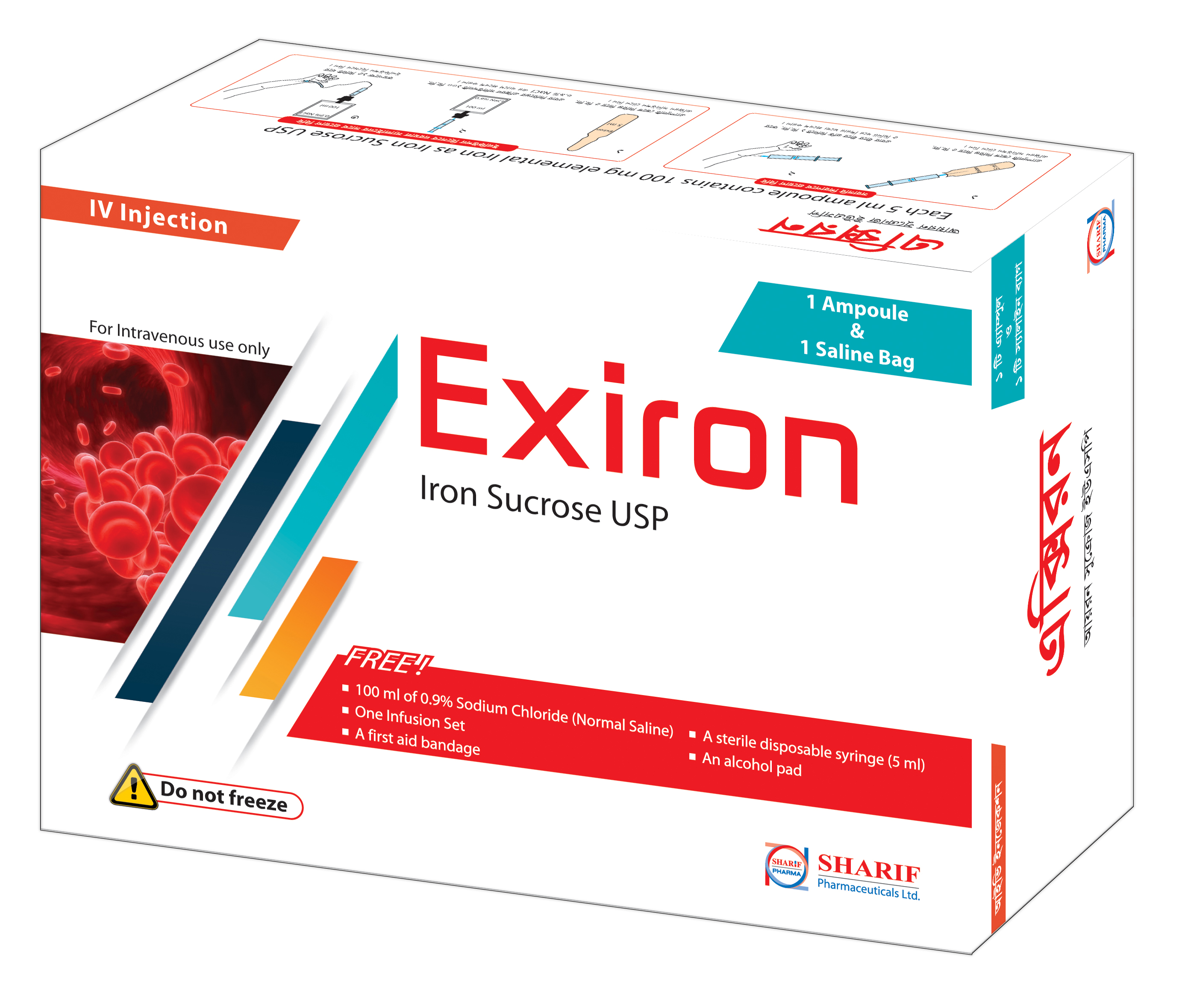COMPOSITION
Exiron Injection: Each 5 ml ampoule contains 100 mg elemental Iron as Iron Sucrose USP.
DESCRIPTION
Intravenous Iron Sucrose is more effective and well tolerated in comparison with oral Iron
preparations and it is the treatment of choice for anemia due to Iron deficiency.
Administration of Iron Sucrose replenishes tissue Iron stores, reverses Iron depletion and
Iron-deficient erythropoiesis and corrects or prevents Iron deficiency anemia.
PHARMACOLOGY
Pharmacodynamics: Following intravenous administration of Exiron, Iron Sucrose is
dissociated by the reticuloendothelial system into iron and sucrose. Iron is transferred from
the blood to a pool of Iron in the liver and bone marrow. Ferritin, an Iron storage protein,
binds and sequesters Iron in a nontoxic form, from which Iron is easily available. Iron binds
to plasma transferrin, which carries Iron within the plasma and the extracellular fluid to
supply the tissues. The transferrin receptor, located in the cell membrane, binds the
transferrin Iron complex, which is then internalized in vesicles. Iron is released within the
cell and the transferrin-receptor complex is returned to the cell membrane. Transferrin
without Iron (apotransferrin) is then released to plasma. The intracellular Iron becomes
(mostly) hemoglobin in circulating red blood cells (RBCs).
Pharmacokinetics: In healthy adults treated with intravenous doses of Iron Sucrose, its iron
component exhibits first order kinetics with an elimination half-life of 6 h, total clearance of
1.2 L/h, non-steady state apparent volume of distribution of 10.0 L and steady state
apparent volume of distribution of 7.9 L. The sucrose component is eliminated mainly by
urinary excretion.
INDICATIONS
Exiron is indicated for the treatment of Iron deficiency in the following indications: .Where there is a clinical need for a rapid Iron supply. .In patients who cannot tolerate oral Iron therapy or who are non-compliant. .In active inflammatory bowel disease where oral Iron preparations are ineffective. .Non-dialysis dependent chronic kidney disease (CKD) patients either receiving or not
receiving an erythropoietin .Hemodialysis dependent-chronic kidney disease (HDD-CKD) patients receiving an
erythropoietin. .Peritoneal dialysis dependent-chronic kidney disease (PDD-CKD) patients receiving an
erythropoietin.
DOSAGE AND ADMINISTRATION
Adults and Elderly: Exiron is exclusively to be administered intravenously by slow injection
or by drip infusion, or directly into the venous limb of the dialyser. Iron Sucrose must not be
used for intramuscular injection.
As Intravenous injection: Iron Sucrose can also be administered undiluted by slow
intravenous injection at a rate of 1 ml Iron Sucrose (20 mg Iron) per minute [5 ml Iron
Sucrose (100 mg Iron) in 5 minutes]. A maximum of 10 ml Iron Sucrose (200 mg Iron) can be
administered per injection in at least 10 minutes.
As Infusion: Iron Sucrose should preferably be administered by drip infusion (in order to
reduce the risk of hypotensive episodes and paravenous injection) in a dilution of 1 ml Iron
Sucrose (20 mg Iron) in max. 20 ml 0.9% Sodium Chloride [5 ml (100 mg Iron) in max. 100 ml
0.9% NaCI etc. up to 25 ml (500 mg Iron) in max. 500 ml 0.9% NaCI]. Dilution must take place
immediately prior to infusion and the solution should be administered as follows: 100 mg
Iron in at least 15 minutes; 200 mg Iron in at least 30 minutes, etc. Normal posology is to use
5-10 ml Iron Sucrose 1-3 times a week depending on the Hemoglobin level. For the
administration of the maximum tolerable dose of 7 mg Iron/kg body weight an infusion
time of at least 3.5 hours has to be respected, independently of the total dose.
Chronic Kidney Disease Patients not on Dialysis: Exiron is administered as a total cumulative
dose of 1000 mg over a 14 day period, or as an infusion of 500 mg of Exiron over a period of
4 hours on day 1 and day 14. Patients weighing less than 70 kg may require longer infusion
times.
Hemodialysis Patients: Exiron is administered as a 100 mg slow intravenous injection or as
an infusion of 100 mg per consecutive hemodialysis session for a total cumulative dose of
1000 mg.
Peritoneal Dialysis Patients: Exiron is administered as a total cumulative dose of 1000 mg in
3 divided doses within a 28 day period. 2 infusions of 300 mg over 1.5 hours 14 days apart
followed by one 400 mg infusion over 2.5 hours 14 days later.
Children: There is a limited data on Children under study conditions. If there is a clinical
need, it is recommended not to exceed 0.15 ml Iron Sucrose (3 mg Iron) per kg body weight
1-3 times a week depending on the hemoglobin level



No review yet